Speech Inflation Targeting and Economic Welfare
It is a great pleasure to address the Anika Foundation lunch for the third time.
I would like to start by winding the clock back, not by three years, but instead by 40 years. It was 40 years ago that I started studying economics in high school in Wagga Wagga. I sat the 3 unit economics exam for the Higher School Certificate (HSC) in 1979. At that time, the standard exam question was in two parts: why did Australia have both high inflation and high unemployment and what should policy do about it? I recall writing numerous essays on this troubling topic.
I also recall learning about the Misery Index. For those of you whose memories don't go back that far, this index is the sum of the unemployment rate and the inflation rate. Few people talk about this index these days, but I thought it would be useful to show it to you as background (Graph 1). As you can see, things were pretty miserable in the 1970s and 1980s. Today, though, at least according to this metric, they are not too bad. The Misery Index is now as low as it has been since the late 1960s. Today, we are living in a world of low and stable inflation and low unemployment. It is useful to remind ourselves of this sometimes.
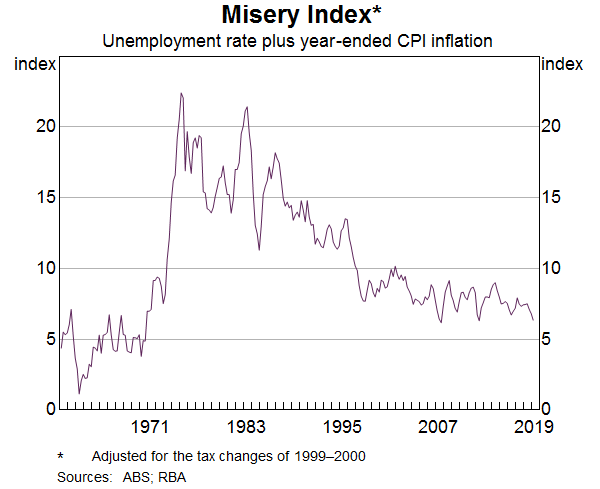
So this means that today's HSC students are likely to be writing about why inflation is so low at the same time that unemployment is also low. I hope that they are also being asked to write about how public policy should respond to low inflation and its close cousins of slow growth in nominal wages and household incomes.
These are important issues to be thinking about. Given this, I would like to use this opportunity to address two related questions that I am asked frequently.
The first of these is why is inflation so low globally and in Australia?
And the second is, is inflation targeting still appropriate in this low inflation world?
I will then draw on my answers to make some remarks about monetary policy here in Australia.
1. Why is Inflation so Low?
It is useful to start off with a couple of graphs.
The first is the average rate of inflation globally (Graph 2). The picture is pretty clear. Global inflation declined over the three decades to the early 2000s and has been low and stable for some time.
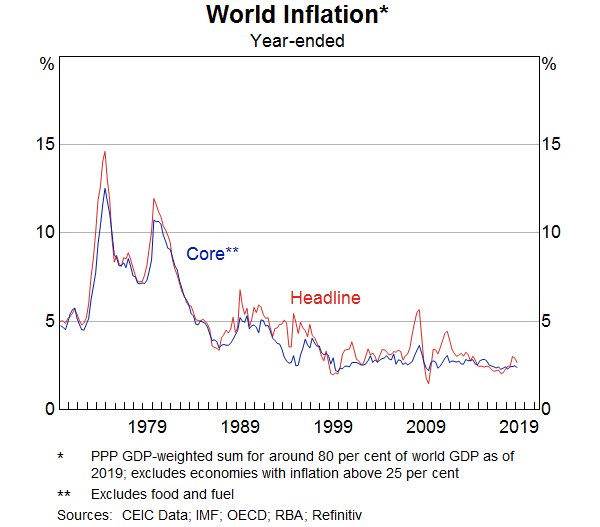
Low inflation has become the norm in most economies. This is evident in this next graph, which shows the share of advanced economies with a core inflation rate below 2 per cent and below 1 per cent (Graph 3). Currently, three-quarters of advanced economies have an inflation rate below 2 per cent, and one-third have an inflation rate below 1 per cent.
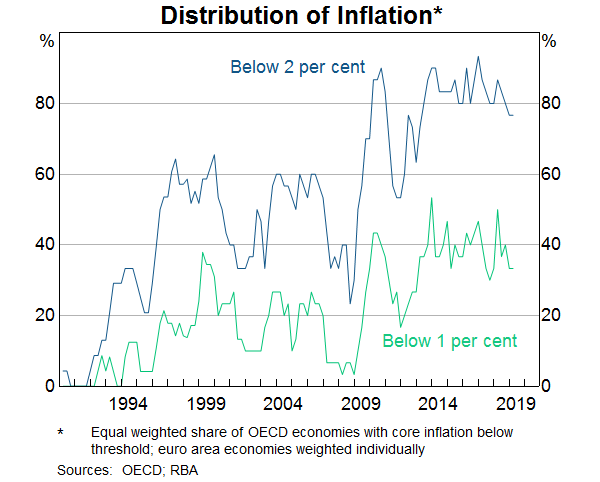
The obvious question is why this has happened?
There is no single answer. But there are three factors that, together, help explain what has happened. These are: the credibility of the current monetary frameworks; the continuing existence of spare capacity in parts of the global economy; and structural factors related to technology and globalisation.
I will say a few words about each of these.
First, the credibility of the monetary frameworks. One of the responses to the high inflation rates of the 1970s and 1980s was to put in place monetary frameworks with a strong focus on inflation control. In some countries, this took the form of rewriting the law to require the central bank to focus on just one thing: inflation. Many countries also adopted an inflation target, with monetary policy decisions being explained primarily in terms of inflation.
This increased focus on inflation has helped cement low inflation norms in our economies. Many people understand that if inflation were to pick up too much, the central bank would respond to make sure the pick-up was only temporary. This means that workers and firms can make their decisions on the basis that the rate of overall inflation will not be too different from the target rate. This has made the system less inflation prone than it once was.
The second explanation for low inflation is the continuing existence of spare capacity in parts of the global economy.
The existence of spare capacity was an important factor explaining low inflation in the aftermath of the global financial crisis. And today, it remains a factor in some countries, including here in Australia. But, on the surface, it is a less convincing explanation for low inflation in countries where unemployment rates are now at multi-decade lows. Based on conventional measures of capacity utilisation, these economies are operating close to their sustainable limits. One explanation for continuing low inflation in this environment is that the current rate of aggregate demand growth is simply not fast enough to put meaningful pressure on capacity. If so, stronger demand growth would be expected to see inflation pick up. Another possibility is that the unemployment rate, by itself, no longer provides a good guide to spare capacity, partly due to the flexibility of labour supply. I will come back to this idea in the discussion of inflation outcomes in Australia.
The third explanation is that globalisation and advances in technology have changed pricing dynamics. There are two main channels through which this appears to be happening. The first is by lowering the cost of production of many goods. And the second is by making markets more contestable and increasing competition. The main effect of these changes should be on the level of prices, rather than on the ongoing rate of inflation. But this level effect is playing out over many years, so it appears as persistently low inflation.
It is widely accepted that the entry into the global trading system of hundreds of millions of people with access to modern technology put downward pressure on the prices of manufactured goods. Reflecting this, goods prices in the advanced economies have barely increased over the past couple of decades (Graph 4). But the effects of globalisation and technology extend beyond this and into almost every corner of the economy, including the services sector.
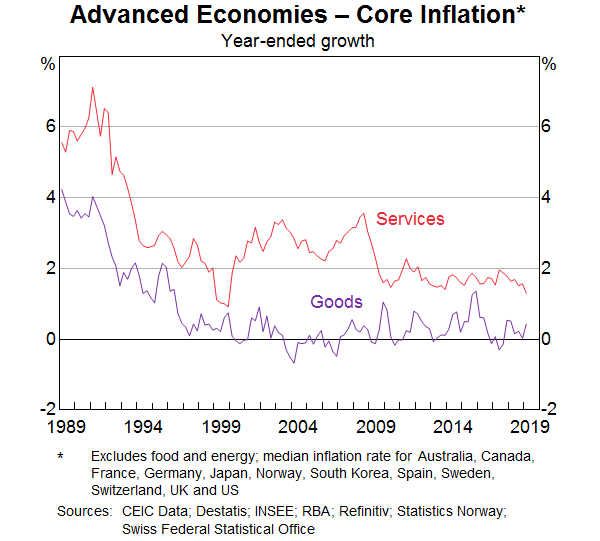
In today's globalised world, there are fewer and fewer services that can be thought of as truly non-traded. Many services can now be delivered by somebody in another country. Examples include: the preparation of architectural drawings, document design and publishing, customer service roles and these days many people in professional services work with team members located in other countries. In addition, many tasks, such as accounting and payroll, are being automated. All this has been made possible by technology and by globalisation.
The new global technology platforms have also revolutionised services such as retail, media and entertainment, and transformed how we communicate and search for information and compare prices.
These changes are having a material effect on pricing, with services price inflation lower than it once was. Many firms know that if they don't keep their prices down, another firm somewhere in the world might undercut them. And many workers are concerned that if the cost of employing them is too high, relative to their productivity, their employer might look overseas or consider automation. And, more broadly, better price discovery keeps the competitive pressure on firms. The end result is a pervasive feeling of more competition. And more competition normally means lower prices.[1]
So these are the three important factors that are contributing to low inflation. None of them by themselves is sufficient to explain what is happening, but together they are having a powerful effect. The current high inflation rates in Argentina and Turkey remind us that globalisation and technology, by themselves, do not drive low inflation. The monetary framework clearly matters too. Weaknesses in that framework still result in high inflation.
2. Is Inflation Targeting Still Appropriate?
This brings me to my second question: is inflation targeting still the appropriate monetary framework for most countries?
It is understandable that people are asking this question. Given the factors that I have just discussed, some commentators have argued that central banks will find it increasingly difficult to achieve their inflation targets. Some then go on to argue that central banks should just accept this, not fight it; perhaps they should shift the goal posts, or even adopt another monetary framework. A related argument is that the very low interest rates that have accompanied the pursuit of inflation targets are pushing up asset prices in an unsustainable way and sowing the seeds for damaging problems in the future.
You might, or might not, agree with these perspectives. Either way, it is reasonable to ask if we are on the right track: is inflation targeting still appropriate?
Before I address this question, I would like to push back against the idea that central banks simply can't achieve their inflation targets. As we all know, some central banks have struggled to achieve their targets over a long period of time; Japan and the euro area are the obvious examples. But this is not a universal experience. Over recent times, inflation has been around target in Canada, Norway, Sweden and the United Kingdom. So the experience is mixed (Graph 5).
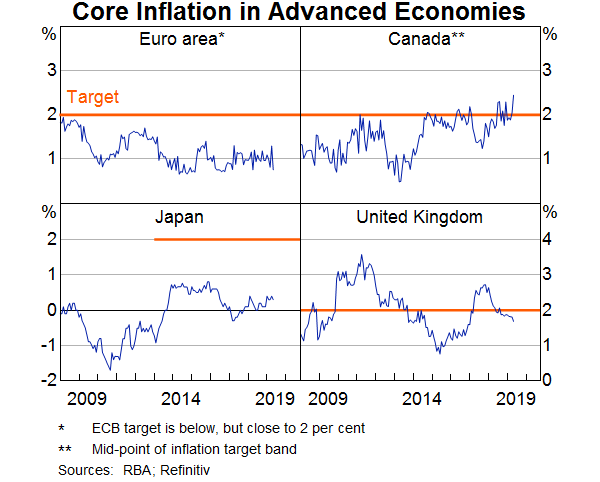
There is no single factor that explains this mixed experience. But countries that are operating nearer to full capacity are more likely to have inflation close to target. It also appears that if you have an extended period of very low inflation – as did Japan and the euro area – it is harder to get back to target as a deflationary mindset takes hold. It is also possible that demographics may be playing a role, although the evidence here is mixed.
Overall, these varying experiences do not support the idea that it has become impossible for central banks to achieve their targets.
Here in Australia, some have argued that a lower inflation target would be a good idea given the ongoing low rates of inflation; that we should adjust our formulation of 2–3 per cent, on average, over time. Lowering the target might have the short-run advantage of allowing us to say we have achieved our goal, but shifting the goalposts hardly seems a good way to build long-term credibility. Shifting the goal posts could also entrench a low inflation mindset.
More broadly, over recent years the international debate has gone in the other direction: that is, to argue for a higher, not lower, inflation target. The argument is that a higher rate of inflation – and thus a higher average level of interest rates – would promote economic welfare by providing more room to lower interest rates, without running up against the lower bound. This greater flexibility for monetary policy could stabilise the economy when it was hit with a negative shock. To be clear, I am not arguing for a higher inflation target, but rather acknowledging there are arguments in both directions.
This brings me back to the question: is inflation targeting still appropriate?
The short answer is yes, but it is important to be clear what this means in practice.
Inflation targeting can mean different things to different people. It comes in different shapes and sizes. Some versions require a central bank to focus on inflation alone and set monetary policy so that the forecast rate of inflation is equal to the target. But inflation targeting does not need to be rigid like this.
In my view, an inflation targeting regime should consist of the following four elements.
-
The inflation target should establish a clear and credible medium-term nominal anchor for the economy.
A high degree of uncertainty about future inflation hurts both investment and jobs. The economy works best if there is a degree of predictability. Most people can cope with some variation in the inflation rate from year to year. But dealing with uncertainty about what inflation is likely to average over the medium term is more difficult. Inflation targeting plays an important role in reducing that uncertainty by providing a strong nominal anchor.
-
The inflation target should be nested within the broader objective of welfare maximisation.
It is worth remembering that inflation control is not the ultimate objective. Rather, it is a means to an end. And that end is the welfare of the society that we serve. I sometimes feel that as some central banks sought to establish their credentials as inflation fighters they over-emphasised the importance of short-run inflation outcomes. And this has been difficult to walk back from. Some central banks have been concerned that if they gave weight to other considerations, the community might doubt their commitment to inflation control. So, it became all about inflation.
But central banks have a broader task than just controlling inflation in a narrow range. They play an important role in preserving macroeconomic stability and thus the steady creation of jobs. Also, their decisions affect borrowing and asset prices and thus financial stability too. Central banks have to determine how to balance these considerations when making monetary policy decisions. This means it makes sense for inflation targeting to be embedded within the broader objective of maximising the welfare of society.
-
The inflation target should have a degree of flexibility.
This is not to say that the target itself should be flexible; this would diminish its usefulness in providing a medium-term anchor. Rather, some variation in inflation from year to year is acceptable and indeed unavoidable. How much variation is too much is difficult to know, but the variation should not be so large that it generates doubt about the commitment of the central bank to achieving the target over time.
-
The inflation target needs to be accompanied by a high level of accountability and transparency.
If the inflation target is operated flexibly and is nested within the broader objective of welfare maximisation, the central bank has a degree of discretion. It is important that when exercising this discretion, the central bank is transparent. Problems can arise if the community doesn't understand the central bank's actions, or if they see it as acting unpredictably or inconsistently with its mandate. This means you should expect us to explain what we are doing, why we are doing it and how we are balancing the various trade-offs.
So these are the four elements that I see as important to an effective inflation-targeting regime.
We have all four elements in Australia. Our commitment to deliver an average inflation rate over time of 2 point something provides a strong nominal anchor. We have always viewed the inflation target in the wider context, reflecting the broad mandate for the RBA set out in the Reserve Bank Act 1959. That Act was passed 60 years ago and has stood the test of time. The RBA was also one of the earliest advocates of flexible inflation targeting – this is evident in our use of the words, ‘on average, over time’ when describing our target. We also place a heavy emphasis on explaining our decisions and their rationale to the community.
Our overall assessment is that Australia's monetary policy framework has served the country well over the past three decades. The flexibility that has always been part of our regime has helped underpin a strong and stable economy and has helped Australia deal with some very large economic shocks. We are not inflation nutters. Rather, we are seeking to deliver low and stable inflation in a way that maximises the welfare of our society.
Over the nearly 30 years we have had the inflation target, inflation has averaged 2.4 per cent, very close to the midpoint. It has, however, been below this average over recent years and I will talk about this in a few moments.
Before I do so, it is important to note that we periodically review the formulation of the current target and examine alternative monetary frameworks, including at our annual conference last year.[2] We are also monitoring closely the discussions that are taking place in the academic community and in other central banks. In my view, the evidence does not support the idea that a change to our inflation target would deliver better economic outcomes than achieved by our current flexible inflation target. Some alternative frameworks would also be more difficult to implement and/or be harder to explain to the community. But it is important that we regularly examine the arguments.
Australian Monetary Policy
I would now like to discuss recent inflation outcomes and monetary policy in Australia.
Like other countries, Australia has had low inflation over recent years. Over the past four years, headline inflation has mostly been below 2 per cent, although it has been slightly above that mark on a couple of occasions (Graph 6). In underlying terms, inflation has been below the band for three years.
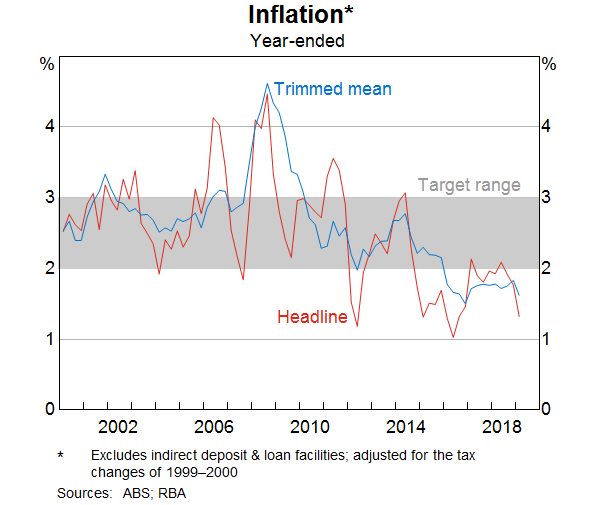
Given this history, it is reasonable to ask why this happened and how the Reserve Bank Board has thought about it.
I will first focus on the period from late 2016 to late 2018. Through most of this period, gradual progress was being made in returning inflation to target and the unemployment rate was moving lower. Inflation was on a gentle upswing and the unemployment rate was coming down more quickly that we had expected. Reflecting this, in August 2017 the two-year ahead inflation forecast was 2½ per cent. Since then it has been lower than this, at 2–2¼ per cent.
Throughout this period, the Board discussed the case for seeking a faster and more assured return of inflation to around the midpoint of the target range. It was natural to be discussing this because having inflation around the midpoint of the target range allows more scope for surprises in either direction.
As you know, in the end the Board did not adjust interest rates through this period. It judged that seeking to achieve a faster return of inflation to the midpoint of the target range would have been accompanied by more rapid growth in debt, at a time when household balance sheets were already very extended. Our judgement was that, given the progress that was being made towards our goals, it was appropriate to use the flexibility in our inflation target to pursue a course that was more likely to be in the country's long-term interest. We could have generated a bit more inflation, but we would have had faster growth in household debt as well.
I acknowledge that others might see this trade-off differently. But given the unemployment rate was coming down and inflation had lifted from its trough, we did not see a strong case for monetary easing.
Towards the end of last year, that assessment began to shift. Inflation was turning out to be lower than we had earlier expected and our forecasts for inflation were being marked down. There are a few reasons for this, but the one I want to highlight today is the flexibility of labour supply, as this links back to my earlier discussion of the reasons for low inflation globally.
When we prepared our forecasts in mid 2017, we did so on the basis that the share of the adult population participating in the labour market (the participation rate) would remain steady over the next couple of years (Graph 7). At the time, this was considered a reasonable forecast: while we expected some increase in participation from an encouraged worker effect because of solid employment growth, we thought this would be offset by the ageing of the population.
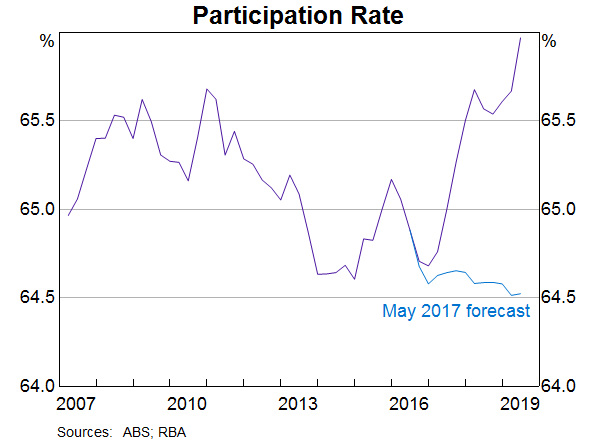
Since then, things have turned out quite differently. Employment growth has been much stronger than expected and the participation rate has risen by 1½ percentage points, which is a large change over a fairly short period. Put simply, the strong demand for labour has been met by more labour supply.
It is useful to consider the following thought experiment. Suppose the participation rate had still risen materially, but by ¾ per cent, rather than 1½ per cent. All else constant, this would have meant the unemployment rate today would have been well below 5 per cent.
This flexibility of labour supply is a positive development and has meant that strong employment growth has not tested the economy's supply capacity. More demand for workers has been met with more labour supply. This has contributed to the subdued wage outcomes over recent times, which in turn has contributed to the low inflation outcomes.
The more flexible supply side means that employment growth can be stronger without fears of overheating. At the same time, the unemployment rate that would put upward pressure on inflation is also lower than it once was.
As the evidence accumulated in support of these propositions, the outlook for monetary policy changed and the Board lowered the cash rate in June and July. In making these decisions the Board also recognised that the earlier concerns about the trajectory of household debt had lessened. The Board has also paid attention to the shift in the outlook for monetary policy globally.
These two recent reductions in the cash rate will support demand in the Australian economy. So too will recent tax cuts, higher commodity prices, some stabilisation in the housing market, ongoing investment in infrastructure and a lift in resource sector investment. We also need to remember that the underlying foundations of the Australian economy remain strong.
It remains to be seen if future growth in demand will be sufficient to put pressure on the economy's supply capacity and lift inflation in a reasonable timeframe. It is certainly possible that this is the outcome. But if demand growth is not sufficient, the Board is prepared to provide additional support by easing monetary policy further. However, as I have discussed on other occasions, other arms of public policy could also play a role in this scenario.
Whether or not further monetary easing is needed, it is reasonable to expect an extended period of low interest rates. On current projections, it will be some time before inflation is comfortably back within the target range. The Board is strongly committed to making sure we get there and continuing to deliver an average rate of inflation of between 2 and 3 per cent. It is highly unlikely that we will be contemplating higher interest rates until we are confident that inflation will return to around the midpoint of the target range.
Thank you for listening. I look forward to answering your questions.
Endnotes
I would like to thank Ellis Connolly for assistance in preparing these remarks. [*]
Conceptually, it is possible to think of these structural factors as adding to global supply, so this third explanation could be seen as elaboration of the second explanation. These structural factors are also likely to be pushing down the equilibrium real rate of interest. [1]
Simon J and M Sutton (eds) (2018), Central Bank Frameworks: Evolution or Revolution? Proceedings of a Conference, Reserve Bank of Australia, Sydney. Available at <https://www.rba.gov.au/publications/confs/2018/>. [2]
